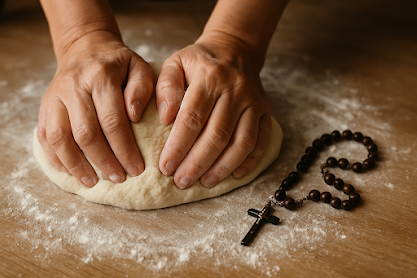In a world that often treats spirituality as something abstract—reserved for church pews or silent meditation—many of us forget that prayer can be tactile. It can be textured. It can smell like garlic and rosemary or feel like yarn slipping through fingers. It can happen while chopping onions, shaping dough, planting basil, or kneeling over a sewing project with aching shoulders and quiet breath.
This is not a lesser prayer. It is a liturgy of movement. It is holy.
The Theology of the Tactile
Catholicism has always honored the body. We mark ourselves with ashes. We kneel. We touch holy water. We taste bread and wine that becomes Body and Blood. In this Incarnational faith, God does not bypass matter—He enters it.
The Catechism of the Catholic Church reminds us that “the human body shares in the dignity of 'the image of God': it is a human body precisely because it is animated by a spiritual soul” (CCC 364). This unity of body and soul means that the work of the hands is not separate from the work of the heart.
In Laudato Si’, Pope Francis writes, “Our bodies are made of his elements, we breathe his air and we receive life and refreshment from his waters” (LS 2). God meets us in the physical. This truth doesn’t vanish when we enter the kitchen or garden—it deepens.
That means your hands can become instruments of prayer, not just when folded, but when engaged in creative, life-giving work.
Cooking for loved ones. Mending clothes. Arranging flowers. Cleaning your home with intention. These aren’t distractions from the spiritual life. They are the spiritual life. When offered with humility and presence, they become part of the “living sacrifice, holy and acceptable to God,” described in Romans 12:1.
Making Ordinary Work Sacred
This isn’t about productivity hacks or performative perfection. It’s about spiritual posture—a way of leaning inward and Godward while you move through the rhythms of daily life.
Here are a few ways to invite prayer into your work with your hands:
1. Begin with a blessing
Before you begin a task, offer it up: “Lord, let this work be fruitful and gentle. May it serve those I love.”
2. Use a repeated motion as a prayer anchor
Stirring, kneading, brushing, folding—these can be matched to breath prayers or the Jesus Prayer. Let your body guide you into rhythm.
3. Offer the work for someone
As you scrub dishes or knit a scarf, offer the action for a friend in need, a soul in purgatory, or someone you find difficult to love.
4. Invite silence
Not every moment needs to be filled with input. Let your hands move in quiet. In the hush, your soul might whisper its truest prayer.
5. Receive grace without needing to earn it
Let your work be an offering, not a transaction. Let it be grace made visible.
A Place in the Monastery
In the Monastery (our sub-brand here at Converting to Hope), we embrace this kind of embodied spiritual life. It’s not about hustle or perfection. It’s about rhythm, beauty, and attention—about sanctifying the ordinary through presence.
A loaf of bread can be a litany.
A batch of soup can be intercession.
A swept floor can be an act of love.
This is not sentimentality. It’s sacramental vision. God is not somewhere else waiting for you to be holier. He is here, woven into the grain of the everyday, waiting to be noticed.
As Gaudium et Spes affirms, “Nothing genuinely human fails to raise an echo in their hearts” (GS 1). Your domestic life—your labor of love—echoes back to the heart of God.
If you’d like more tools for building a rhythm of sacred work, we invite you to explore our spiritual journals and printable tools in the Monastery section of our Ko-fi shop.
Final Thought: Your Hands Remember
Even when your mind is tired or scattered, your hands remember. They know how to stir, fold, scrub, chop. They know how to serve and to shape. Let that be enough. Let it be prayer.
In the kitchen, at the sink, in the stillness of craft or care—this is where heaven and earth can meet.
God is not waiting for you to be still before He shows up. Sometimes, He is already beside you at the stove.
And that counts too.

.png)

.png)
.png)
.png)
.png)

.png)